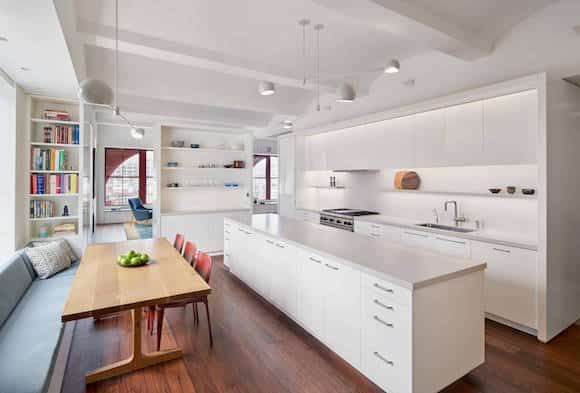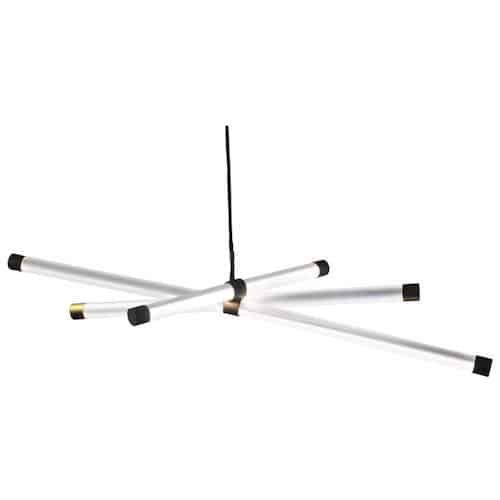
Drew McGukin’s design for a high-rise apartment in Chelsea, New York, offers plenty of sunlight by day and dramatic illumination from a Lindsey Adelman chandelier by night. Photo by Brett Beyer
Choosing the right lamp, chandelier, sconce or bulb can be a daunting task. It’s best to approach the lighting of a room with a mindset that is one-part practical and one-part aesthetics-driven, which should ensure that a space — and its occupants — feels balanced. For insight on infusing one’s interior with illumination and subsequent mood-boosting properties, lighting designers David Weeks and Kristin Victoria Barron share their bright advice.
“Jewelry for the Home”

Asymmetrical lighting fixtures by David Weeks enabled architect Dana Tang of Gluckman Tang to reconcile the vaulted ceiling in this Tribeca, New York, kitchen. Photo by Bruce Damonte
“Jewelry for the home” is how the wildly creative, New York–based designer David Weeks has described his pieces. “I always fixate on the inherent sculptural nature of the lighting design,” Weeks says. He uses a range of exquisite materials to create his signature multi-pronged chandeliers. “The utility always orients the design to a certain extent, but for me, it never inhibits the aesthetic presentation.”
Similarly, Kristin Victoria Barron of Kriest in Los Angeles seeks to let her creative vision drive her design from the beginning. “My work comes from my dream imagery,” Barron says. “Lighting seemed like a natural vehicle for my process because it marries the physical and ephemeral. I sculpt forms as a way to meditate.” Choosing a light fixture is akin to picking a work of art. You will be coexisting with it for quite some time. Opt for a piece that makes you happy when it’s on — and off.
Dim Thinking

A stark hallway provides the perfect backdrop for a sculptural array of pendant lights in this Paris home designed by Isabelle Stanislas Architecture. Photo by Olivier Löser
“I vouch for dimmers, hands down, in everything,” says Weeks. “Throughout the day, you’re going to need different amounts of light in the same space.” He recommends having a single fixture that contains a lot of low-watt light bulbs. This is “especially important in larger, communal spaces. It lends to a softer effect. That’s the intention of most of our mobiles and pendant lights. With extended arms and lots of light sources, the whole space is lit more comfortably.”
Weeks also cites dimmers as crucial for finding that balance in daily transitions. “There’s that half hour of darkness at dusk when you’re waiting to turn the lights on. That’s a magic moment. Dimmers and soft light make that transition really smooth. A fixture may be like a piece of jewelry, but the light itself is best when you don’t notice it.”
Cozy & Intimate Spaces

As this preppy Hamptons bedroom by Kemble Interiors demonstrates, lamps around the bed are a comfortable necessity. Photo by Ball & Albanese
It is no wonder Barron finds that many of her lamps fit nicely by the bedside. It is, after all, “the room where [my ideas were] conceived,” she says. “I often struggled with the scale and feel of bedside table lamp options. When I was designing my Orchis collection, especially the Orchis Japser I, I chose the proportion very deliberately.” She also opts for warmer-temperature bulbs (2,700K to 3,000K) in the bedroom. “You want a softer, warmer temperature to help prepare the body for sleep. Cooler light is akin to early-morning light and signals the body to wake up. It can be disruptive to sleep patterns in the evening.”
Bulbs 101

In a Paris foyer by Dimore Studio, a luminous mobile greets all who enter the home. Photo by Mai-Linh
Weeks, who’s known for his ceiling fixtures with a multitude of bulbs, notes that it is crucial to use the same bulb in these type of designs. “If different light bulbs are being used on the same fixture, there’s a discordance that really throws the ambiance off. Hard bright bulbs are generally too abrasive. A single fixture with a bunch of [the same] bulbs can combat that.” In recent years, LED bulbs have made huge headway in the design industry and are being adopted in interiors for their eco-friendly benefits. Weeks himself recently released his first LED collection, OTTO.
“I like the concept of LED from a sustainability standpoint since the bulbs last a lot longer,” Weeks says. Still, he cautions “we do have to consider that the bulbs cast a different hue of light. We’re doing a lot of experimenting, because the industry continues to outdo itself year after year. We’re playing off that progress.” Barron has a similar assessment of the evolving LED industry. “They are so much more efficient, which is excellent for Mother Earth. There are still holes in the market for certain LED equivalents to incandescent options, but the gap is closing rapidly.”
Consider Everything

Natural light and designer fixtures complement one another in this eclectic New York office and study by Brian J. McCarthy.
“When you’re shopping for a fixture, consider how it will interact with your windows and your natural light,” says Weeks. “Use the room and its function to inform your lighting design.” The easiest way to start? Listen to your space. Barron notes that “all spaces pose an inherent energy and feeling. There is often a transformation that we wish to create as designers. To create the bridge from what exists to what we desire something to be requires listening and sensitivities to all the elements in a space.” While all furnishings serve as part of creating a room’s tableau, lighting is in a unique position. It is “simultaneously physical and ephemeral,” says Barron. “In the creation of an environment it is essential to have one foot in each world.”












